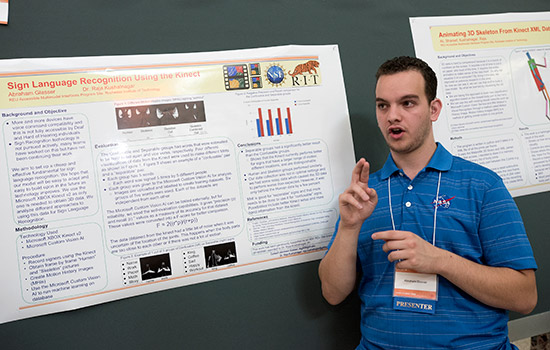Undergraduate student innovators unveil research at 26th annual symposium
Event featured research projects geared toward problem solving and making an impact
A. Sue Weisler
Fateemah Saleem, a second-year student in RIT’s biomedical sciences program, explains her research on “Dispersin B against streptococcus mutans and otopathogens” to College of Liberal Arts faculty member Cecilia Ovesdotter Alm.
Rochester Institute of Technology student Elizabeth Pattie understands how research impacts lives. Her mother lives with multiple sclerosis—one of the reasons Pattie is compelled to continue making inroads in the fields of immunology and disease treatment using pharmaceuticals. Her project, “Targeted Molecular Imaging Agents to Visualize Breast Cancer,” was among more than 250 student projects, representing all nine colleges, on display at the 26th annual Undergraduate Research Symposium on Aug. 4 at RIT. Research proposals were featured in a series of oral and poster presentations throughout the day.
The event, which took place in Louise M. Slaughter Hall and Sustainability Institute Hall, is structured as a professional research conference. Some of the research themes included biomedical and life sciences; optics, photonics and imaging; energy and sustainability; business; chemistry and materials sciences and engineering; computer modeling, design and simulation; ecology; and social sciences and humanities.
“Many research universities around the country don’t offer this type of experience for undergraduates,” said John-David Rocha, an assistant professor in RIT’s College of Science and a faculty mentor to students. “At RIT, when we make this type of experience a central focus for them, they can really see the impact that it has, not just for their own research but in the broader scientific community. It’s a big deal for them to feel that. This is how I started as a freshman undergraduate student 20-plus years ago. Someone gave me the opportunity to work in a lab and figure out what it means to be a scientist. For me, as an educator and a scientist, it’s all about training. For them to learn and understand how to be the scientist who can change that world, that’s my goal.”
This year’s presentations featured a gamut of far-reaching innovations—from researching accessibility and inclusion strategies in postsecondary classrooms, to computational power of quantum Turing machines, to applying green infrastructure to vacant parcels for storm-water abatement.
“This experience has been amazing,” said Pattie, a senior biotechnology student from Kansas City, Mo., who is interested in cancer biology, immunology and molecular genetics. “Last fall, I was able to attend the American Society of Cell Biology conference in San Francisco, which was a great learning experience that allowed me to realize what I don’t know and what is out there. It helped me figure out what specialties I get excited about, what kind of graduate schools I want to look for. The whole research component allows you to think like a scientist. A invaluable exercise as an undergrad is to problem solve, figure things out, and that’s where a lot of really interesting discoveries come from.”
Other student projects included:
- Emily Joslyn, a fourth-year psychology student in the College of Liberal Arts, has always loved children and one day hopes to work as a school psychologist. She is studying the impact that substance use across generations has on parenting styles. Through the distribution of three surveys, Joslyn is gathering information from 90 participants who are answering questions about their own substance use, the parenting that they received as children, and the parenting they give their own children now. Her hypothesis is that parents who were exposed to negative parenting and substance abuse will have a similar experience with their own children. “I was looking for research that will one day translate into a career,” said Joslyn, who is from Albion N.Y. “I spoke with faculty members in my department, sharing my thoughts and interests, and they helped me develop my research.”
- Sun Yue, Zhang Zehao and Wang Chenyu, Chinese students majoring in management information systems from Beijing Jiaotong University, researched Kodak’s viability in the global market as part of their Saunders College of Business poster submission. “Our innovation for Kodak is a new dynamic printing technology to print live photos for two to five seconds which would replace static pictures and video,” said Yue. “Just like Harry Potter, we want to make photos more vivid, dynamic and magical.”
The keynote speaker for the symposium was Christopher Schauerman, research scientist and co-director of the RIT/NY-BEST Battery Prototyping Center, which works closely with local and national battery startup companies and universities to commercialize new battery technologies.
The symposium is sponsored by RIT’s Office of the Vice President for Research.
 Abraham Glasser, an RIT/NTID student studying computer science in the B. Thomas Golisano College of Computing and Information Sciences, studied “Sign Language Recognition Using Kinect Data.” A. Sue Weisler
Abraham Glasser, an RIT/NTID student studying computer science in the B. Thomas Golisano College of Computing and Information Sciences, studied “Sign Language Recognition Using Kinect Data.” A. Sue Weisler
 More than 250 undergraduate student research projects were on display in Sustainability Institute Hall with a series of oral presentations held in Louise M. Slaughter Hall. A. Sue Weisler
More than 250 undergraduate student research projects were on display in Sustainability Institute Hall with a series of oral presentations held in Louise M. Slaughter Hall. A. Sue Weisler








